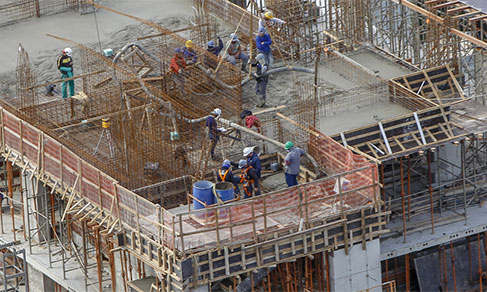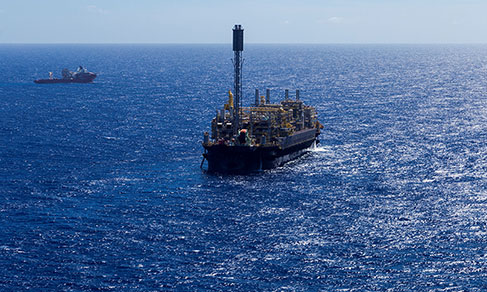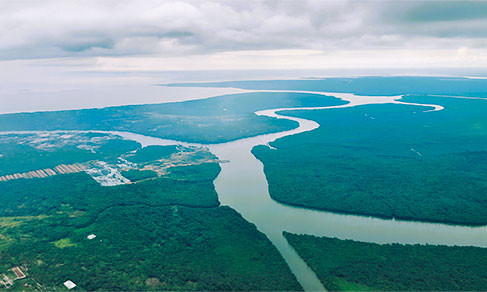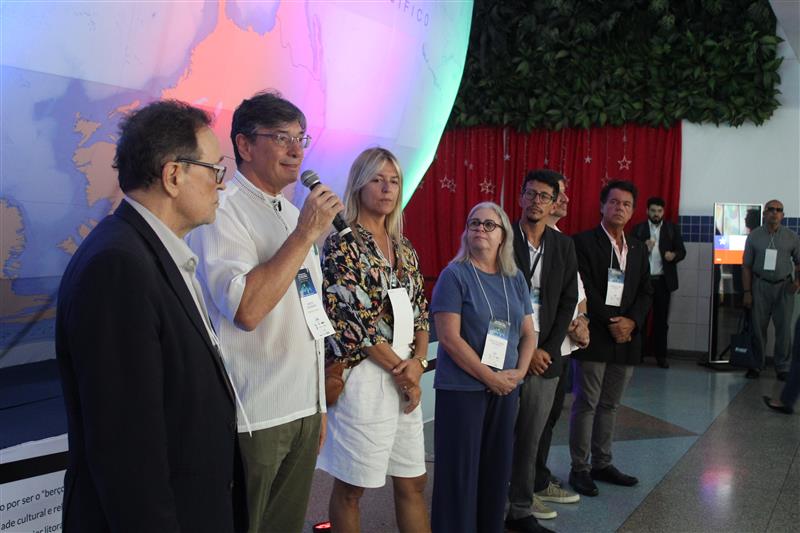Forestry Activities
Value of forestry production increases by 11.9% and hits record figure of R$33.7 billion
September 27, 2023 10h00 AM | Last Updated: October 05, 2023 03h00 AM
Highlights
- In 2022, the value of forestry production reached a record of R$33.7 billion, an increase of 11.9% from 2021, and output from 4,884 municipalities.
- The value of silviculture (planted forests) increased by 14.9% and reached R$27.4 billion. As for wild crop harvesting increased, there was an increase of 0.2%, amounting to R$6.2 billion.
- Planted forest grew by 0.1%, a total of 9.5 million hectares, of which eucalyptus, mainly used in the pulp industry, amounted to 77.3%.
- Almost all the silviculture groups recorded increase in value of production. Eucalyptus leaf was the only product to drop (3.6%), whereas the all the other recorded output increase, mainly firewood, up by 33.4%.
- Minas Gerais keeps the highest value of production in silviculture, and reached R$7.5 billion in 2022, or 27.3% of the total. The state is the main producer of charcoal, with 87.7% of the national volume.
- General Carneiro (PR) now leads the ranking of production value of silviculture, and reached R$ 625.8 million in 2022, the highlight being the increase of 10.2% in the amount of wood for pulp and paper and and of 35.3% in the total value of production.
- Among the 20 municipalities with the highest forestry production figures, 17 stand out in terms of exploitation of planted forests, and, the remaining ones, of wild crop harvesting.
- The group of wood products accounted for the biggest share of value of production of wild crop harvesting (63.1%). It recorded a slight drom from the previous year, after a significant increase of 37.9% in 2021.
- The states of Mato Grosso and Pará accounted for 71.4% of the total logges wood extracted, which represents 83.4% of the value of production of this product.
- In 2022, the value of production of non-wood products recorded an increase of 1.9%, a total of R$2.3 billion. Acai berry, with R$830.1 million, and yerba mate, with R$ 648.5 million, are the products generating highest value of production figures
- .

Value of production of forestry activities reached a record of R$33.7 billion, with an increase of 11.9% and output from 4,884 municipalities. Value of production of silviculture (planted forests) still exceeds that of wild crop harvesting, which has been observed since 1998. Silviculture remains on an upwardmtrend as observed in the last few years, having reached R$27.4 billion, an increase of 14.9% from the result of 2021 (R$23.9 billion).
Wild crop harvesting remained almost unchanged, with an increase of 0.2% from the result of a year ago (31.5%). the value of production of 2022 amounted to R$6.2 billion. Data come from the survey Forestry Activities (PEVS) 2022, released today (27) by the IBGE.
“Wild crop harvesting recorded a significant increase in 2021, having reached 31.6%. In 2022, with this high basis for comparison, it was practically stable, with a change of 0.2%. Silviculture remained on an upward trend since 2020,” says the manager of the IBGE, Carlos Alfredo Guedes.
He explains that, every year, silviculture has had a trend to increase in value of production, and wild crop harvesting, a rend to decrease. That does not mean that wild crop harvesting has been decreasing, but, on the contrary, that the value of silviculture products has been increasing.
“As for results by Major Region, the highlight in the Southeast is eucalyptus; in the South, pinus prevails; in the Northeast, wood harvesting, food products and waxes stand out; in the North, wood harvesting and acai are the highlights; in the Central West, eucalyptus crops and wood harvesting,” the manager explains.
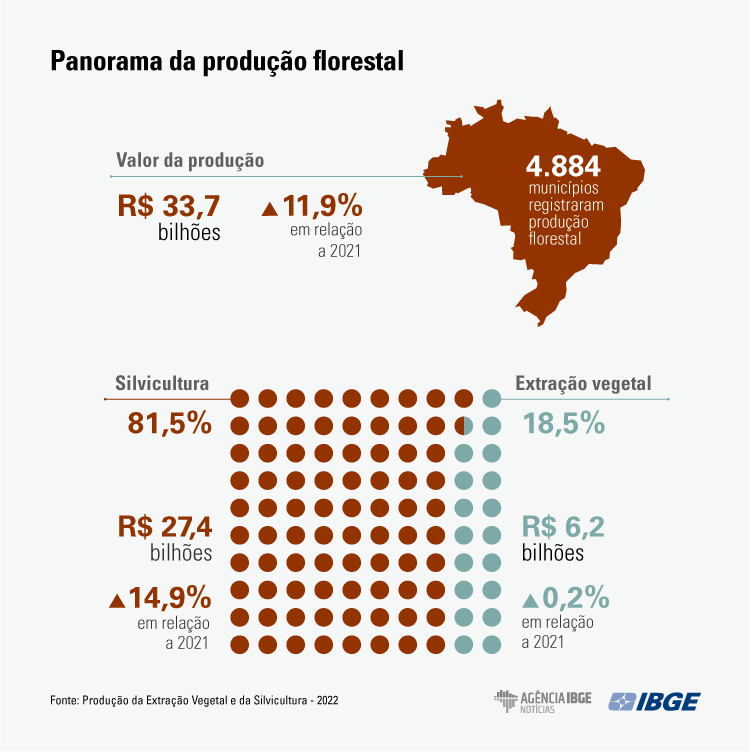
In 2022, there was an increase of 0.1% in the forests planted in the country, that is, by more than 8.1 thousand hectares. The total area for silvicultures is 9.5 million hectares, of which 7.3 million, or 77.3% are eucalyptus, which is predominatly used in the pulp industry. Eucalyptus and pinus were responsible for the coverage of 96.0% of the areas of planted forests for commercial purposes.
The Southeast (0.4%) and Central West Regions (5.5%) recorded increases in 2022. The South Region, which represents 32.4% of the areas of forests planted with pinus and eucalyptus in the country, dropped by 1.1%.
According to data from the Secretariat of Foreign Trade (SECEX), of the Ministry of Development, Industry, Trade and Services, pulp was in the eleventh position in the ranking of otal exports in 2022 (2.5%), with 19.8 million tonnes exported, which generated 8.4 billion dollars, an increase of 24.6%. The sector of logged wood for pulp and paper remains on an upward trend, and reached the figure of R$ 9.0 billion, an increase of 25.5% in value of production, after the increase of 24.4% recorded in 2021.
“Brasil is the main exporter of pulp, and the production of logged wood for pulp and paper hit a record figure in 2022, having reached 99.7 million cubic meters. The second biggest volume in the series was that of 2018, when production reached 92.7 million cubic meters,” the researcher explains.
The participation of wood products reached 96.0% of value of forestry production. Wood products from planted areas for commercial purposes recorded an increase of 15.5% in value of production, whereas wild crop harvesting recorded a drop of 0.8%. “These results confirm the trend to increase of wood products from silviculture and the stability in products from wild crop harvesting in 2021,” Mr. Guedes adds.
Among wood products from silviculture, there was increase in the value of production of all groups, with firewood recording the highest figure, an increase of 33.4%. Value of production of wood for the production of pulp and paper increased by 25.5%; charcoal, by 6.8%; and logged wood for other purposes, by 5.6%.
Wild crop harvesting, which had been dropping in the time series of the last few years, recorded an increase of value added in 2019 (6.9%), 2020 (6.3%), 2021 (31.5%), with a relatively high basis for comparison; in 2022 the increase was of only 0.2%. Whereas food products account for almost all the value of production of silviculture (96.0%), in wild crop harvesting this group represents 63.1%, followed by food products (30.4%), waxes (4.4%), oilseeds (1.5%) and other (0.6%).
Minas Gerais has highest value of silviculture production R$ 7.5 billion
Minas Gerais keeps the highest value of silviculture production, which increased by 2.6%, and reached R$ 7.5 billion in 2022, or 27.3% of the total of silviculture. It is also the main producer of charcoal, with 87.7% of the national volume.
Paraná comes in the second position in terms of value of planted forests: R$ 4.8 billion. It is the third main producer of logged wood for pulp and paper, being responsible for 16.3% of the national production. Production increased by 3.0%, having reached 16.2 million cubic meters, and the value of production increased by 2.4%, having reached R$ 1.7 billion. Logged wood for other purposes also stood out, and hit 20.9% million cubic meters, a decrease of 4.9%, which represents 35.7% of the national total, and remained as the main producer in the country.
In terms of planted area, Minas Gerais still registers the biggest area covered with forest species planted in the country, with 2.1 million hectare, meaning an increase of 0.3% from the previous year, being the majority planted with eucalyptus. São Paulo accounts for the second highest area of planted forests, with 1.2 million hectares, of which 80.8% are eucalyptus forests. A highlight is the increase of planted area in Mato Grosso do Sul, which reached 1.2 million hectares, an increase of 13.2%, almost all of it planted with eucalyptus.
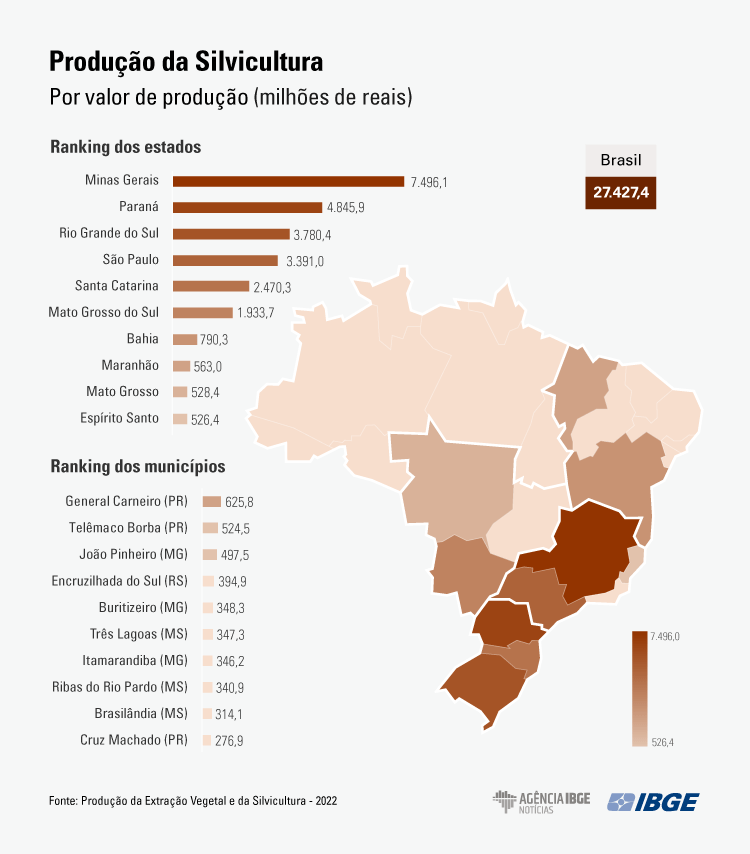
Among the 10 biggest municipalities with areas of planted forests in Brazil, five are located in Mato Grosso do Sul, three in Minas Gerais, one in Rio Grande do Sul and one in Bahia.
Four municipalities in Mato Grosso are in the fist positions regarding planted areas in the country, among which stand out: Três Lagoas and Ribas do Rio Pardo, with the biggest areas of planted forests, with 264.2 thousand hectares and 251.3 thousand hectares, respectively. Na Bahia, o destaque é Caravelas, enquanto no Rio Grande do Sul, Encruzilhada do Sul, where the areas are divided into eucalyptus and pinus.
Paraná leads national production of firewood for silviculture
Paraná was another highlight in terms of production of wood log from planted forests, with an estimated amount of 13.9 million cubic meters which corresponds to 26.3% of the national total. Rio Grande do Sul was the second main producer of firewood, and reached 11.5 million cubic meters, 21.8% of the national total. The South Region accounts for 63.2% of the national production of firewood.
General Carneiro is the municipality with the highest value of silviculture production
General Carneiro (PR) took the leadership of the ranking of value of silviculture production, and reached a total of R$ 625.8 million in 2022, with a highlight to the increase of 10.2% in the quantity of logged wood for pulp and paper and of 35.3% in the total value of production. Logged wood for other purposes increased by 8.8% and, consequently, increased the value of production by 30.6%.
The Municipaliy of Telêmaco Borba (Paraná), second Município in the ranking of value of silviculture production, with R$ 524.5 million, stood out in terms of logged wood, with 584.7 thousand cubic meters, leading to R$ 27.4 million, with an increase of 667.4%.
João Pinheiro (Minas Gerais), leader of the ranking in 2021, was the third Municipality with highest value of silviculture production, generating R$ 497.5 million as a national highlight in the production of coal, with 437.8 thousand tonnes, despite the decrease of 7.8% in terms of volume, against the previous year. Another highlight in the silviculture sector was the municipality of Encruzilhada do Sul (Rio Grande do Sul), with the fourth biggest value of production, R$ 395.0 million.
Wild crop harvesting increases by 0and generates R$ 6.2 billion in value of production
In 2022, the value of production obtained by means of wild crop harvesting had an incremwent of 0.2%, amounting to R$ 6.2 billion. Among the groups of products that form wild crop exploitation, reduction in volume of production was recorded by the following groups: wood (0.8%), waxes (6.8%), fibers (3.4%) and pine wood (28.8%).
The group of wood products recorded the biggest participation in value of production of wild crop harvesting (63.1%), but dropped by 0.8% against the previous year, after a significant increase of 37.9% in 2021. Following the trend of the last few years, when wild crop exploitation of wood had been losing positions in the country, being gradually replaced by planted forests. In 2022, there were positive changes in value of production of charcoal (11.0) and of firewood (14.4%), and a decrease of logged wood (5.7%); this group of products registered a total of R$ 3.9 billion, 0.8% less from 2021.
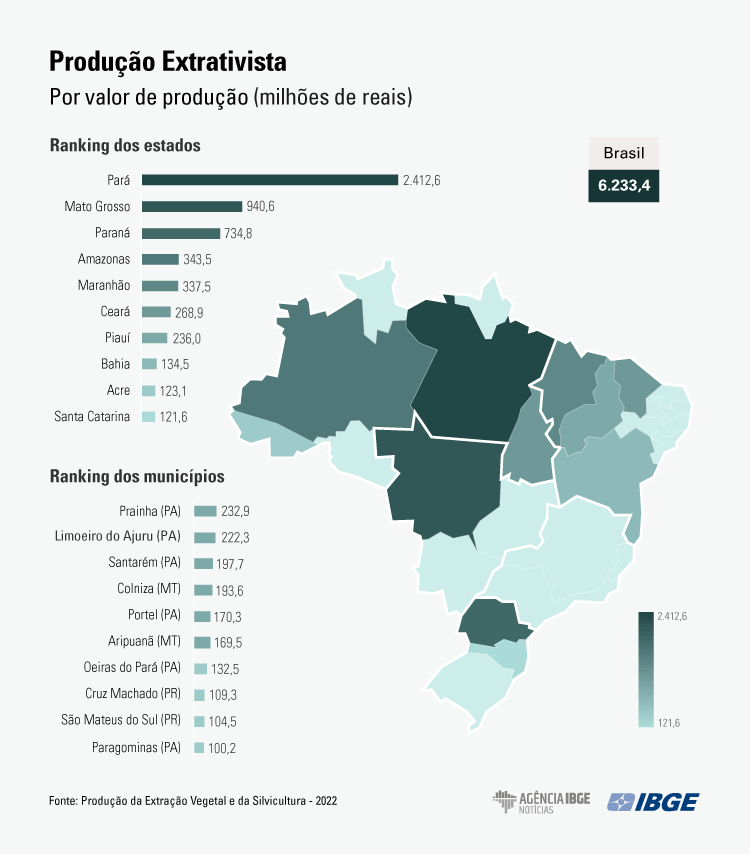
The states of Mato Grosso and Pará accounted for 71.4% of the total extracted amount of logged wood, representing 83.4% of the value of production of this product. Pará, which surpassed Mato Grosso once more as the main producer, reached 4.7 million cubic meters with an increase of 22.7% in extraction of logged wood.
The main producer of Pará is charcoal, which recorded an increase of 88.2%, and reached 139.4 thousand tonnes, which represented 29.9% of the national total.
Acai and yerba mate keep highest value of production among non-wood products
In 2022, the total value of production of non-wood products increased by 1.9%, which amounted to R$ 2.3 billion. Acai, with R$ 830.1 million, and yerba mate, with R$ 648.5 million, are products accounting for higher values of production. Among food products, acai and yerba mate, Brazil nut, pequi (nut) and pine nut accounted for 43.8%, 34.2%, 9.0%, 2.7% and 2.7%, respectively.
More about the survey
PEVS 2022 presents information about area, amount produced and value of production considering the exploration of planted forests (silviculture) and of natural vegetation resources (wild crop harvesting).
Forestry encompasses 37 items, among which the highlights are: wood products, food products, waxes and oilseeds. In silviculture, seven products are investigated, including charcoal, firewood, logged wood and resin.











